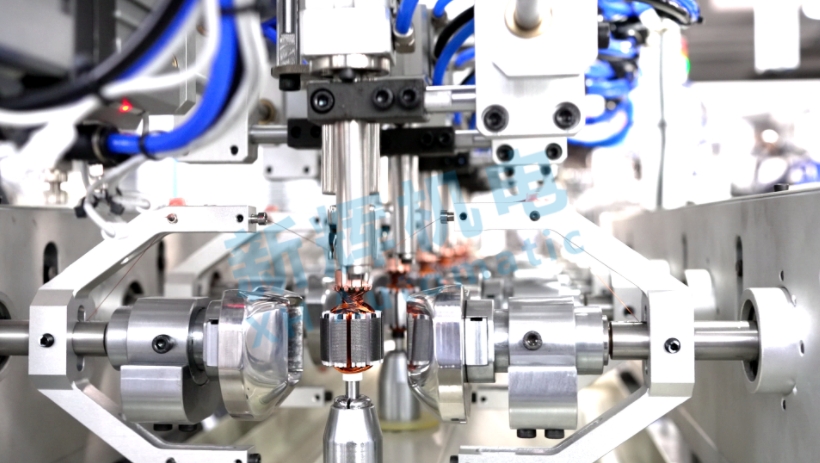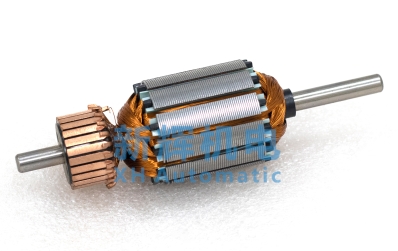What spare parts are needed for motor motor rotor automatic six-station double flying fork winding machine and how to set up guarantee stock?
I. Spare parts list
(A) Mechanical parts
1、Transmission parts
Belt and chain: Since the belt and chain are prone to wear, elongation or breakage during long-term use, it is necessary to prepare an appropriate amount of spare belt and chain. According to the model and specifications of the equipment, reserve different sizes of belts and chains to ensure that they are fully matched with the original transmission components of the equipment.
Gears: Gears are key components in the transmission system and may suffer from tooth wear, tooth root fatigue fracture and other problems due to long-term friction, overload and other reasons. Stock up on gears of common specifications, including those related to flying fork drives, rotor indexing, and so on.
Timing Wheels and Timing Belts (if applicable): Timing wheels and timing belts are used for precision drives in some winding machines. Their wear and tear will affect the accuracy of the winding, so you need to prepare some of them as spares and pay attention to their type and accuracy requirements.

2、Flying fork and fixture parts
Flying fork: Flying fork may be damaged during high-speed movement, such as deformation of the fork head and wear of the rotating shaft. Stock up complete flyer fork assembly or key flyer fork parts, such as fork head, rotor shaft, bearings, etc., so that they can be replaced in time when the flyer fork fails.
Fixture collets and connecting rods: Fixture collets are prone to wear, resulting in failure to securely clamp the rotor, while damage to connecting rods can affect the opening and closing action of the fixture. Prepare a variety of specifications of collets and connecting rods to meet the needs of different sizes of rotor clamping.
Bearings for Flying Forks and Clamps: Bearings are the key components to ensure the smooth movement of flying forks and clamps. Since the bearings may be worn out and damaged by overheating under high load operation, it is necessary to stock various types of bearings, including those used for the rotary axis of the flying fork and the rotary axis of the fixture.
3、Guide rail and slide
Guide rail: Wear on the surface of the guide rail will affect the movement accuracy of the flying fork and other moving parts. Reserve and equipment supporting the guide rail, its length and accuracy should be in line with the equipment requirements. At the same time, the material and installation method of the guide rail should be considered to ensure that the reserve can be installed smoothly.
Slider: The slider is used in conjunction with the guide rail, and damage or wear of the slider will lead to motion jamming. Prepare a sufficient number of sliders, and pay attention to the size, shape and material of the slider to match the guide rail.
(II) Electrical components
1、Motor and driver
Flying fork motors and rotor indexing motors: motors are the power source of the winding machine and may fail due to overloading, short-circuiting, and prolonged operation. Reserve motors of the same type as the original motor of the equipment, including its power, speed, torque and other parameters should be identical.
Motor Driver: The driver is used to control the motor's speed, direction and other parameters. If the driver fails, the motor will not work properly. Prepare the corresponding spare drive, and be familiar with its parameter settings and debugging methods, so that after replacement can quickly restore the normal operation of the equipment.
2、Sensors
Position sensor: Position sensors are used to accurately control the position of the flying fork, rotor indexing and so on. Reserve different types (such as photoelectric sensors, Hall sensors, etc.) and specifications of the position sensor, to ensure that its detection accuracy and installation size and equipment requirements.
Tension Sensors: Tension sensors are critical to ensuring the quality of the winding. Since tension sensors may be affected by environmental factors, long-term use, etc. and suffer from decreased accuracy or damage, spare tension sensors should be prepared and need to be calibrated after replacement.
Counting Sensors: Counting sensors are used to count the number of turns wound. Reserve counting sensors to cope with the situation of inaccurate counting of turns due to sensor damage.
3. Controllers and Boards
Programmable Logic Controller (PLC): The PLC is the core of the control system of the winding machine. Although the PLC is relatively stable, program errors, hardware failures, etc. may occur. Prepare a spare PLC or its key module, and keep a backup of the device's program so that the program can be quickly restored after replacing the PLC.
Control circuit boards: These include motor driver boards, signal processing boards, and various other circuit boards. The electronic components on these boards may be damaged, such as capacitor leakage and chip burnout. Reserve some commonly used control circuit boards, and to understand their functions and wiring in order to replace them in case of failure.
4、Electrical connection parts
Power and signal cables: Power and signal cables may be broken and aged during long-term use. Reserve wires of different specifications, including wire diameter, insulation materials and other parameters to meet the equipment requirements. At the same time, prepare some wire connectors, such as plugs, sockets, terminals, etc., for wire connection and replacement.
Relays and contactors: Relays and contactors are used to control the on-off of circuits and the conversion of signals. They may malfunction due to worn contacts, damaged coils, and so on. Keep a stock of relays and contactors of different sizes and voltage levels to ensure that they can be replaced in time when required.

(iii) Other parts
1. Pneumatic or hydraulic components (if applicable)
Cylinders and hydraulic cylinders: If the winding machine adopts pneumatic or hydraulic clamps, the cylinders or hydraulic cylinders may have problems such as leakage and piston damage. Stock the appropriate cylinders and hydraulic cylinders and note that their working pressure, stroke and other parameters match the equipment.
Pneumatic or hydraulic piping and fittings: Piping may be cracked or aged, and fittings may be loose or leaking. Stock up on various sizes of piping and fittings, including air hoses, oil hoses, quick couplings, etc., so that they can be replaced in a timely manner when problems arise.
Pneumatic or hydraulic valves: such as solenoid valves are used to control the flow direction and pressure of gases or liquids. Stock up different types and specifications of valves to cope with situations where the pneumatic or hydraulic system cannot work properly due to valve failure.
2、Lubrication and cooling components
Lubricating oil and grease: Regularly adding lubricating oil and grease to the mechanical parts of the equipment is an important measure to ensure the normal operation of the equipment. Reserve enough lubricating oil and grease, and according to the requirements of the equipment to choose the right type, such as high temperature lubricant, high-speed grease.
Cooling Fans and Heat Sinks (if applicable): For some higher power motors or drives, cooling fans or heat sinks may be required to prevent overheating. Stock cooling fans and radiators, and be careful to match their size, airflow, and other parameters with the equipment.
Second, the protection of inventory setting method
(A) Based on the frequency of equipment failure
1、Historical data statistics
Collect the past failure records of the winding machine, including the type of failure, the time of failure, the spare parts required for repair and other information. Through the analysis of these data, determine the failure frequency of each spare part. For example, it was found that belts fail on average every three months, while gears fail less frequently, about once every two years.
The quantity of safeguarded stock is determined on the basis of the frequency of failure. For the high failure frequency of spare parts, such as belts, should maintain a relatively large inventory, such as stocking 3 - 5; for the lower failure frequency of gears, you can stock 1 - 2.
2、Equipment running time estimation
Consider the impact of equipment running time on spare parts. If the equipment running time is longer, then the wear and tear of the components will be accelerated, and the frequency of failure will be increased accordingly. According to the expected operating time of the equipment and the service life of each component, calculate the number of possible failures, so as to determine the guarantee stock. For example, it is known that the service life of the motor is 5,000 hours, the equipment runs 8 hours a day, 250 days a year, then the annual running time of the motor is 2,000 hours, about every two and a half years the motor may fail, according to which the number of guaranteed stock of the motor can be determined.
(ii) Consideration of procurement cycle and supplier response time
1. Purchasing cycle assessment
Understand the procurement cycle of each spare part, i.e., the time required from the issuance of a purchase order to the receipt of goods. Spare parts with a long procurement cycle require more guaranteed stock. For example, for some special specification sensors, the procurement lead time may be as long as 3 - 4 weeks, then sufficient quantities need to be stocked to cover possible failures during this period.
Also, consider the reliability of the supplier. If the supplier's delivery times are erratic or there is a risk of supply interruptions, then additional safeguard stock is also required. Partnerships can be established with multiple suppliers to reduce supply risks.
2、Emergency procurement channels
In addition to regular procurement channels, the establishment of emergency procurement channels is also an important addition to set up guarantee inventory. Identify some suppliers who can provide emergency supply services, although it may pay a higher price because of emergency procurement, but in the event of a shortage of key components can be supplemented in a timely manner to avoid prolonged equipment downtime. For example, for some key components that are prone to sudden and unpredictable failures, such as PLC controllers, ensure that there is an emergency procurement channel and that there is a certain amount of reserves in the guaranteed inventory.
(C) combined with the production task and the importance of equipment
1, production task priority
According to the priority of production tasks to adjust the guarantee inventory. If the winding machine for the production line of a key product is critical to the production, then the winding machine for the spare parts to ensure that the inventory should be increased appropriately. For example, if the winding machine is the production of a high-value, urgent orders for the production of key equipment, in order to avoid equipment downtime affect the production schedule, you need to ensure that there are enough spare parts, even if the failure frequency of certain components is low, you can also increase the inventory.
2、Equipment downtime cost estimation
Consider the cost of equipment downtime, including production losses, maintenance costs, penalties for delayed delivery. If the cost of equipment downtime is high, then there is a need for a more adequate guarantee inventory to reduce the risk of downtime. For example, through costing, it is found that each day of downtime of a coil winding machine will result in $10,000 in production losses and maintenance costs, so in order to minimize such losses, it is necessary to reasonably increase the guaranteed inventory of spare parts to ensure that the equipment can be restored to operation as soon as possible.
※ If you need help, please contact Xinhui's technical specialists through the page chat tool for assistance.








